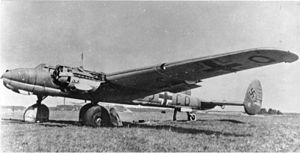Messerschmitt Me 261
| Me 261 Adolfine | |
|---|---|
 |
|
| Messerschmitt Me 261 V2, BJ+CQ, in Lechfeld, 1944, following damage in an air raid | |
| Role | Long range reconnaissance aircraft |
| Manufacturer | Messerschmitt |
| First flight | 23 December 1940 |
| Introduction | Never introduced |
| Primary user | Luftwaffe |
| Number built | 3 |
The Messerschmitt Me 261 Adolfine was a long-range maritime reconnaissance aircraft designed in the late 1930s. It looked like an enlarged version of the Messerschmitt Bf 110. It was not put into production.
In 1937, Messerschmitt began Projekt P. 1064, a study for a long-range reconnaissance aircraft, and took the basic design of the Bf 110 twin-engine heavy fighter as its basis. The P. 1064 had a long, slim fuselage with two wing-mounted engines. The aircraft was planned from the outset as a record-breaking aircraft, but after becoming convinced that the aircraft was capable of taking the world long-distance flight record, the German Air Ministry approved the project and gave it the designation of 8-261.
The intended goal of the project was for an example of the aircraft to carry the Olympic Flame from Garmisch-Partenkirchen, Germany (site of the 1936 Winter Olympics) to Tokyo, Japan for the 1940 Summer Olympics in what would be a record-breaking nonstop flight (5870 mi / 9445 km). The plan captured the imagination of Adolf Hitler at an early stage in its design and in tribute, the aircraft carried the unofficial name: Adolfine.
The Me 261 incorporated a number of features which were highly advanced for its day. The single-spar all-metal wing was designed to serve as a fuel tank and its depth at the wing root was only slightly less than the height of the fuselage. The fuselage itself was of virtually rectangular section, with space for five crew members, consisting of two pilots seated side-by-side with the radio operator directly behind in the front compartment, while a navigator and a flight engineer were housed in the rear fuselage under a stepped, glazed station.
...
Wikipedia
